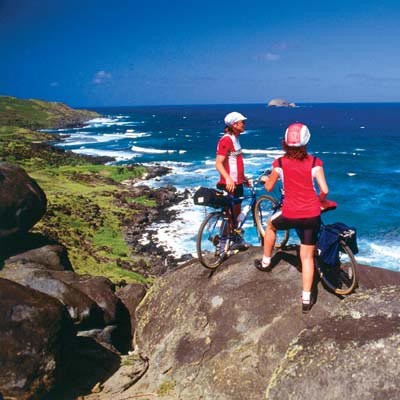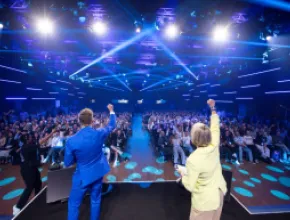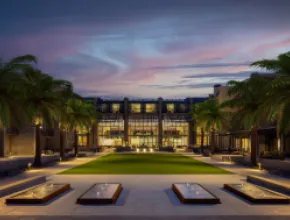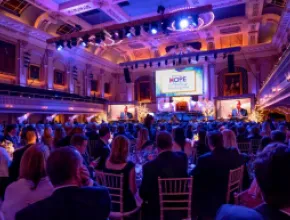For decades, American travelers have made a beeline for the archipelago of Hawaii, which offers an unmatched combination of familiarity, as an English-speaking destination that uses U.S. currency, and exotic allure, with its gorgeous tropical ambience and distinctive heritage. The islands of Maui, Lanai and Molokai are favorites in particular for groups interested in modern amenities, cultural flavor and pristine natural beauty, without the crowds of Waikiki.
Maui
Largest of the Maui Nui island cluster, Maui mixes robust technology and astronomy sectors with a rich agricultural heritage, with farmers continuing to produce coffee, macadamia nuts, papayas, tropical flowers, pineapples, and sugarcane. More so than the rest of Hawaii, Maui’s waters are also brimming with marine life such as whales in the midst of their annual migration from Alaska. During the winter months, thousands of humpbacks can be seen frolicking in the channels between Maui and its neighboring islands.
As with many meetings destinations, Maui is attracting an increasing amount of family business, with children and spouses accompanying visiting delegates for a working vacation.
“We’re also seeing more planners incorporate a cultural aspect into the meeting,” says Tom Risko, director of meetings, conventions and incentives for the Maui Visitors Bureau.
Participating in a traditional Hawaiian luau is always popular, according to Risko, but he says groups are also utilizing elements in their events such as an opening chant, an opening hula performance and video introductions spotlighting Maui today and in the past.
Maui has plenty of culturally infused diversions to offer groups once the meeting wraps.
Guided and self-guided walks through historical Lahaina are popular among attendees. A former whaling harbor, Lahaina was once also the Hawaiian Kingdom’s royal capital. Today, its narrow streets are lined with shops and seafood restaurants, and the docks bristle with fishing and leisure boats. Visitors often take breaks from the sun underneath an enormous banyan tree in the town square.
The Maui Ocean Center presents guests with dozens of living exhibits and boasts the largest tropical aquarium in the Western Hemisphere. Many displays provide an up-close experience, from outdoor touch pools, where you can feel the skin of a giant ray, to a 750,000-gallon tank of colorful fish and turtles, accessed by an acrylic tunnel. Whenever a shark is brought into or released from the aquarium, it is blessed by one of the center’s Hawaiian cultural advisors. (Sharks are considered to be na ‘aumakua, or “deified ancestors,” by old Hawaiians.) Digital audio guides provide colorful commentary and are available in English, Spanish, German, and Japanese. And if you’re lucky, when exiting the center you might even see a group of whales breaching just outside.
Another favorite group experience is nighttime star-gazing from the rooftop of the Hyatt Regency Maui Resort & Spa in Kaanapali. Visitors can learn how early Polynesian sailors navigated canoes through the oceans solely by memorizing the movements of stars, 500 years before the invention of the sextant.
The outrigger canoe and cultural experience at The Fairmont Kea Lani Maui is also popular with visiting groups, Risko says. Participants can learn how to paddle a canoe and take a guided tour of native plants and learn how they’re used by Hawaiians.
Meanwhile, group activities and excursions can range from helicopter adventures to snorkeling and diving trips, parasailing, golfing, and mountain bike rides from the summit of Mount Haleakala. Team-building programs offered by Hawaiian Corporate Games & Events include everything from a tribal raft challenge to sand creations, road rallies, rodeos, and beach olympics.
Maui does not have a convention center or a conference center, but the state’s largest hotel ballroom sits within the meetings-ready Grand Wailea Resort Hotel & Spa.
Several other well-equipped meetings resorts are located on the western and southern side of the island, spread throughout resort communities such as Kapalua, Kaanapali, Wailea, and Makena. Top group properties include The Ritz-Carlton, Kapalua; Hyatt Regency Maui Resort & Spa; Sheraton Maui; Westin Maui; Wailea Beach Marriott Resort & Spa; The Fairmont Kea Lani; and Maui Prince Hotel. The exclusive Four Seasons Resort Maui at Wailea caters mainly to small corporate meeting and incentive groups.
On the island’s southeastern side, the secluded Hotel Hana-Maui is a favorite destination for executive retreats, incentive rewards and small corporate or board meetings. Nearby Hamoa Beach has been described by James Michener as “the most perfect crescent beach in the Pacific.”
Property improvements are always in progress on Maui.
The AAA Five Diamond Ritz-Carlton, Kapalua just wrapped up a $95 million renovation and expansion, and the Four Seasons Resort Maui at Wailea just completed a makeover of all 380 rooms and suites, and recently debuted DUO Steak and Seafood restaurant, Maui’s newest culinary jewel.
The Royal Lahaina Resort continues its $330 million renovation to all 12 floors of the 330-room Lahaina Kai Tower. By 2010, the property will have added 125 villas, a freestanding spa, a swimming pool, a children’s center, and a restaurant.
Additionally, Grand Wailea Resort Hotel & Spa just embarked on a $50 million renovation that will include upgrades to its 780 guest rooms as well as the lobby and other areas of the property. The project is slated for completion by mid-2008.
Lanai and Molokai
The smaller islands of Molokai and Lanai are more laid-back than Maui, and both are ideal for meeting planners seeking a unique destination for small group programs, executive sessions, and eco and adventure experiences. Both are easily accessible via ferry service from Maui.
On Molokai, native Hawaiians constitute a majority of the population, which means traditional values and customs are the norm.
Accommodations range from the quaint open-air bungalows of Hotel Molokai to the Lodge & Beach Village at Molokai Ranch, which includes 22 guest rooms at the lodge and 40 upscale beachfront “tentalows” on platform decks with lounge chairs, a picnic table, a bathroom, and heated showers. Meeting and theater rooms and open-air function sites are located at or near the lodge.
Outdoor activities are plentiful, from hiking through wildlife sanctuaries and cultural sites to mountain biking, horseback tours and water activities. Organized tours provide breathtaking trips to the island’s sea cliffs, the tallest in the world, with dramatic waterfalls feeding into the ocean.
Almost all of Lanai is privately owned and feels like Hawaii used to be, with little traffic and no fast food joints anywhere in sight.
“Board retreats are common on Lanai before or after the board meeting on Maui or Oahu,” Risko says.
The island is known for its spectacular golf and snorkeling and diving opportunities.
Two luxurious, award-winning resorts form the hub of business accommodations here.
The 215-room Four Seasons Resort Lanai at Manele Bay sits atop a cliff overlooking Hulopoe Bay and boasts The Challenge at Manele, a Jack Nicklaus-designed golf course with holes actually built onto the cliff.
The elegant Lodge at Koele is designed in the manner of a gentlemen’s mountain lodge and attracts smaller corporate meeting groups. Its golf course, The Experience at Koele, was created by Greg Norman and Ted Robinson, and features panoramic vistas of Molokai and Maui.
Together, the two resorts offer more than 300 guest rooms and suites, with indoor and outdoor meeting facilities.
Four Seasons Resort Lanai at Manele Bay just completed a $50 million enhancement, which included Hale Halawai, a new 51,000-square-foot oceanview ballroom and terrace. The 102-room Lodge at Koele, now also under Four Seasons management, just finished its own $50 million facelift, with completely refurbished guest rooms, an expanded pool area, and a spa and wellness center.
Meanwhile, the historic 11-room Hotel Lanai, once a retreat for Dole Plantation executives, just opened Lanai City Grille, a restaurant headed by award-winning chef Beverly Gannon. Her tantalizing Pacific Fusion menu is enhanced by live music every Friday under the stars.
In addition to golf and water fun, Lanai also offers 80,000 acres of countryside, which visitors can explore by Jeep or mountain bike. An afternoon of sightseeing can include ancient temples and rocks carved with Hawaiian petroglyphs, the island’s famous Shipwreck Beach, and a wind-carved geological wonder known as the Garden of the Gods.
“The fact that groups can travel by ferry from one island to another is unique,” Risko says. “With there being no traffic lights, no commercialism on Lanai or Molokai, it’s a nice complement to Maui.”
For More Info
Lanai Visitors Bureau 808.565.7600
www.visitlanai.net
Maui Visitors Bureau 888.918.8444
www.mauimeetings.net
Molokai Visitors Association 808.553.3876
www.molokai-hawaii.com






